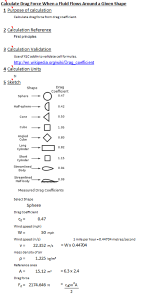Calculate Drag Force When a Fluid Flows Around a Given Shape.xlsx

Description
In fluid dynamics, the drag coefficient is a dimensionless quantity that is used to quantify the drag or resistance of an object in a fluid environment, such as air or water. It is used in the drag equation, where a lower drag coefficient indicates the object will have less aerodynamic or hydrodynamic drag. The drag coefficient is always associated with a particular surface area.
Calculation Reference
Drag coefficient
Fluid mechanics
Streamline shapes
To calculate the drag force (F_d) acting on an object when a fluid flows around it, you can use the following equation based on the drag coefficient (C_d), fluid density (ρ_f), reference area (A), and the relative velocity between the object and the fluid (V):
F_d = 0.5 * C_d * ρ_f * A * V²
Here are the steps to calculate the drag force:
-
Determine the fluid density (ρ_f): You need to know the density of the fluid (e.g., air, water) in which the object is submerged or moving. Fluid density is typically expressed in kg/m³ or lb/ft³. For example, the density of air at sea level and at 20°C is approximately 1.2 kg/m³, and the density of water is approximately 1,000 kg/m³.
-
Determine the reference area (A): The reference area depends on the object's geometry and orientation relative to the fluid flow. For most objects, the reference area is the cross-sectional area perpendicular to the flow direction. For example, for a cylinder or a sphere, the reference area would be the circular cross-sectional area.
-
Determine the relative velocity (V): The relative velocity between the object and the fluid is the speed at which the fluid is flowing around the object or the speed of the object through the fluid. This velocity is typically given in m/s or ft/s.
-
Determine the drag coefficient (C_d): The drag coefficient is a dimensionless quantity that depends on the object's shape, surface roughness, and the flow conditions (e.g., Reynolds number). For some common shapes, you can find the drag coefficient in fluid dynamics textbooks or engineering handbooks. For more complex shapes, you may need to refer to experimental data, numerical simulations, or wind tunnel testing.
-
Calculate the drag force (F_d): Plug the values for C_d, ρ_f, A, and V into the equation to calculate the drag force acting on the object.
Keep in mind that this equation assumes steady, incompressible flow and neglects effects like turbulence or compressibility, which may be significant in some cases. In practice, always consult with a fluid dynamics expert or use computational fluid dynamics (CFD) simulations to obtain accurate results for complex shapes or flow conditions.
The drag coefficient (Cd) depends on several factors, including the shape of the object, the Reynolds number, and the roughness of the surface. Therefore, it is difficult to provide a single value for the drag coefficient of a particular cross section. However, here are some typical drag coefficients for common cross sections at a Reynolds number of around 10^5:
- Sphere: Cd = 0.47
- Cylinder: Cd = 1.17
- Flat plate perpendicular to flow: Cd = 1.28
- Flat plate parallel to flow: Cd = 0.82
- Airfoil: Cd = 0.04 - 0.15 (depending on the shape and angle of attack)
It is important to note that these values are only approximate and may vary significantly depending on the specific conditions and geometry of the object. Additionally, these values are for incompressible flow and may not be applicable for high-speed or compressible flow.
Calculation Preview
Full download access to any calculation is available to users with a paid or awarded subscription (XLC Pro).
Subscriptions are free to contributors to the site, alternatively they can be purchased.
Click here for information on subscriptions.


